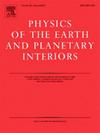铁-镍-硅合金在堆芯条件下的电导率和导热率:再评价
IF 1.9
3区 地球科学
Q2 GEOCHEMISTRY & GEOPHYSICS
引用次数: 0
摘要
我们给出了固体六方密包(hcp)和液体Fe-10 at的电阻率(电导率的反比)的实验结果。% Ni-22.5 at。% Si (Fe-11.8 wt% Ni-12.7 wt% Si)合金在高压和高温条件下,对应于地球的外核条件,使用金刚石砧细胞。我们发现hcp Fe-Ni-Si合金的电阻率对温度的依赖性最小,表明热化学诱导的电阻率饱和。我们还观察到电阻率饱和度降低了熔化转变过程中电阻率变化的程度。根据我们的研究结果,我们估计外核顶部的岩心电阻率上限约为110 μΩcm (= 1.10 × 10−6 Ωm),对应于电导率和热导率的下限分别约为9.2 × 105 Sm−1和90 Wm−1 K−1。如此高的地核导电性是不可避免的,在理解地球的热演化过程中必须加以考虑。由于缺乏对温度、压力和杂质影响之间相互作用的理解,对铁及其合金的电阻率实验室观察的核心条件的推断受到了阻碍。D. Stacey和O. L. Anderson(2001)。本文章由计算机程序翻译,如有差异,请以英文原文为准。
Electrical and thermal conductivities of Fe–Ni–Si alloy under core conditions: A reevaluation
We present experimental results on the electrical resistivity (the inverse of electrical conductivity) of solid hexagonal close-packed (hcp) and liquid Fe–10 at.% Ni–22.5 at.% Si (Fe–11.8 wt% Ni–12.7 wt% Si) alloys under high-pressure and high-temperature conditions, corresponding to the Earth's outer core conditions, using a diamond anvil cell. We found minimal temperature dependence of the resistivity of the hcp Fe–Ni–Si alloy, indicating thermochemically-induced resistivity saturation. We also observed that the resistivity saturation reduced the extent of resistivity change during the melting transition. Based on our findings, we estimate an upper limit for the core resistivity of approximately 110 μΩcm (= 1.10 × 10−6 Ωm) at the top of the outer core, corresponding to a lower limit for the electrical and thermal conductivities of approximately 9.2 × 105 Sm−1 and 90 Wm−1 K−1, respectively. Such high core conductivity is unavoidable and must be accounted for in understanding the Earth's thermal evolution.
“Extrapolation to core conditions of laboratory observations of electrical resistivities of iron and its alloys has been hampered by lack of understanding of interactions between the effects of temperature, pressure and impurities.”—F. D. Stacey and O. L. Anderson (2001).
求助全文
通过发布文献求助,成功后即可免费获取论文全文。
去求助
来源期刊

Physics of the Earth and Planetary Interiors
地学天文-地球化学与地球物理
CiteScore
5.00
自引率
4.30%
发文量
78
审稿时长
18.5 weeks
期刊介绍:
Launched in 1968 to fill the need for an international journal in the field of planetary physics, geodesy and geophysics, Physics of the Earth and Planetary Interiors has now grown to become important reading matter for all geophysicists. It is the only journal to be entirely devoted to the physical and chemical processes of planetary interiors.
Original research papers, review articles, short communications and book reviews are all published on a regular basis; and from time to time special issues of the journal are devoted to the publication of the proceedings of symposia and congresses which the editors feel will be of particular interest to the reader.
 求助内容:
求助内容: 应助结果提醒方式:
应助结果提醒方式:


